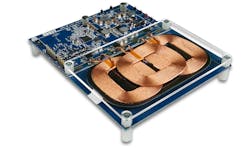IDT Launches First In-Vehicle Wireless-Charging Reference Design
Last week, Integrated Device Technology (IDT) introduced a turnkey Customer Reference Board (CRB) targeting automotive equipment manufacturers. The P9261-3C-CRB reference kit consists of a three-coil Wireless Power Consortium (WPC) Tx-type reference board and a 15-W receiver board, as well as design collateral. It is based on IDT’s P9261 AEC-Q100 chipset combined with the WPC-qualified MP-A13 3-coil transmitter.
An associated layout module enables quick implementation on a system board, while a fully-tested bill of materials (BOM) simplifies component selection. The P9261-based kit meets the AEC-Q100, grade 2 automotive standard and CISPR-25 EMI/EMC performance.
The WPC Qi (pronounced CHEE) qualified solution complies with the WPC Qi Baseline and Extended Power Profiles to 15 W, as well as offering iOS and Android proprietary fast-charging modes. By way of background, Qi is an open interface standard that defines wireless power transfer using inductive charging over distances of up to 4 cm. The system utilizes a charging pad and a compatible device, which is placed on top of the pad, charging via resonant inductive coupling.
"IDT believes that the Automotive CRB will fuel the growth of in-car device wireless charging by providing equipment makers with a faster, painless, low-risk path to adoption," says Laurence McGarry, marketing director of IDT's Wireless Power Division. "In laboratory tests, we measure more than 5% improvement in efficiency compared to more complex competitive solutions while meeting the tough EMI specifications for automotive designs."
The reference design is supported by a graphical user interface (GUI) that allows customers to tune parameters such as foreign object detection (FOD), protection limits, and timing. The end result is a faster time-to-market experience.
Transmitter Features
The P9261 AEC-Q100-qualified transmitter IC combines high-voltage integration, including current sensing and MOSFET drivers, with an Arm 32-bit M0 core-based processor that leads to higher performance in less board space than competitive offerings, according to IDT. The integrated microcontroller offers OTP program memory and supports external flash memory.
Features such as LED patterns, FOD, or the over-temperature threshold can be customized with the chip. The device supports the I2C serial interface protocol, which enables the user to control the basic parameters, such as operating mode, switching frequency, input current, and input voltage.
Depending on the product code, the transmitter can function with a single coil (P9260) or multiple coils (P9261) in a full-bridge or half-bridge inverter configuration. It supports charging of up to 15 W.
The transmitter generates power through the power coil, detects the presence of a wireless power receiver, decodes the communication packets from the receiver, and adjusts the transmitted power by controlling the voltage based on feedback from the receiver. It will enable the power receiver to output 15 W if the bidirectional communication protocol can be established, or the power receiver will output only 5 W for a standard 5-W power receiver.
The product is rated over an operating temperature range of −40 to +105°C. It comes in a compact 7- × 7-mm 48-pin QFN and wettable flank RoHS-compliant packages (0.5-mm pitch). All additional components on the CRD are AEC-Q100-qualified as well.

